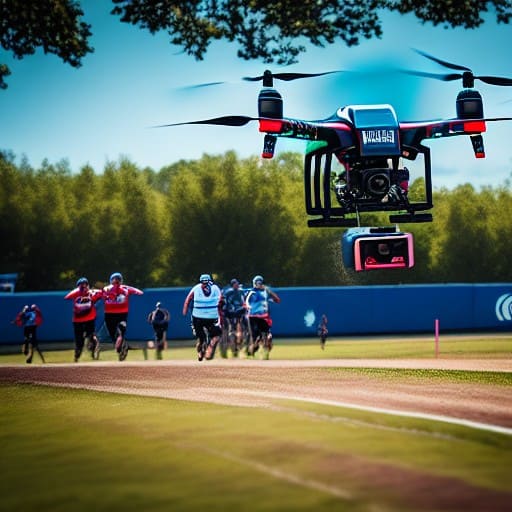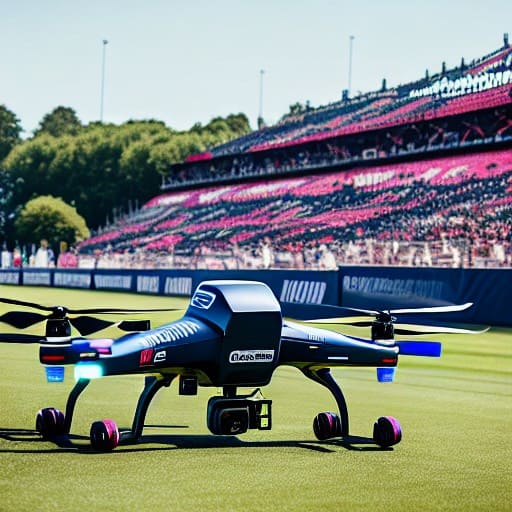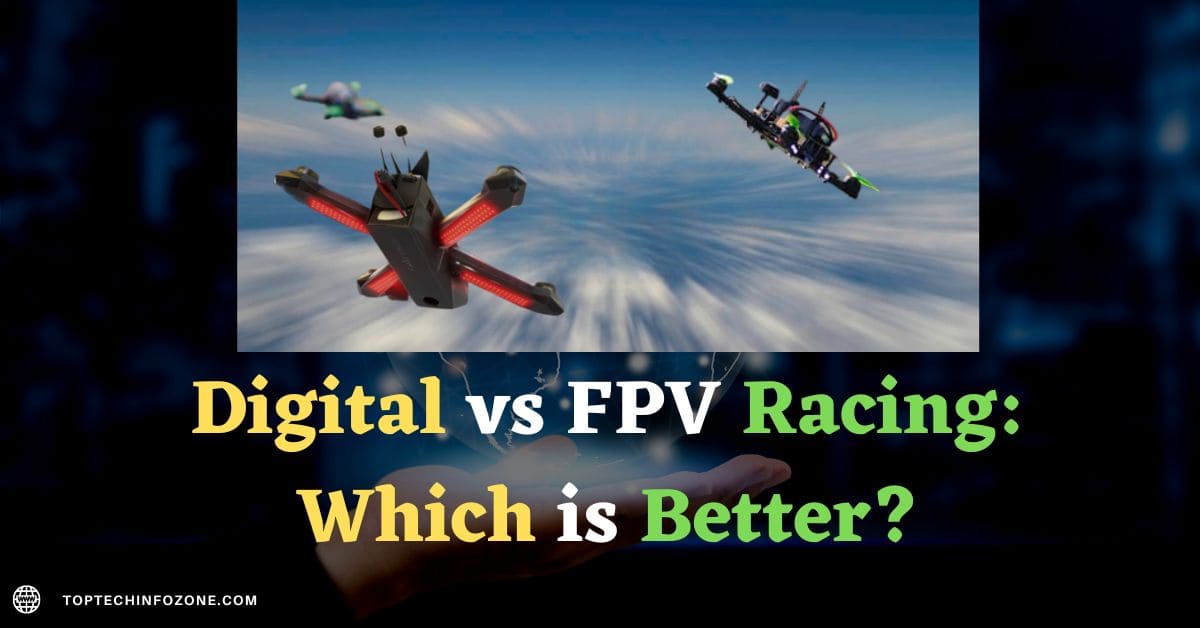Racing drones (FPV Racing) is a thrilling hobby that has gained significant popularity in recent years. With the advent of new technologies, drone racing has evolved and become more accessible to a wider audience. Two types of drone racing are commonly practiced: digital racing and FPV racing. Both types of racing have their own unique characteristics and appeal to different audiences. In this article, we’ll discuss the differences between digital and FPV racing, their advantages and disadvantages, and which one may be better suited for you.
Introduction
Racing is an exhilarating activity that provides a rush of adrenaline and a sense of competition. There are two primary types of racing: FPV racing and digital racing. FPV racing is a type of racing where the pilot controls the vehicle from a first-person view (FPV) using a headset that displays a live video feed from the vehicle’s camera. Digital racing, on the other hand, is a type of racing where the pilot controls a virtual vehicle in a digital environment using a computer or gaming console.
Both FPV and digital racing have their own unique advantages and challenges. In this article, we will explore each type of racing in detail and help you decide which one is the best fit for you.
Explanation of the Two Racing Types
FPV racing and digital racing are two very different types of racing, each with its own set of rules and equipment requirements.
FPV Racing
FPV racing is a type of racing where the pilot controls a small drone or RC vehicle from a first-person view (FPV) using a headset that displays a live video feed from the vehicle’s camera. The pilot wears the headset to see what the vehicle sees and controls the vehicle using a remote control. FPV racing is typically done in an outdoor environment, and pilots race against each other on a designated course.
Digital Racing
Digital racing, also known as sim racing or e-racing, is a type of racing where the pilot controls a virtual vehicle in a digital environment using a computer or gaming console. The pilot uses a controller or a steering wheel and pedals to control the vehicle, and the race takes place in a virtual environment. The pilot races against other players from around the world on a virtual race track.
The Beginning of FPV Racing
FPV racing started around 2014, when drone enthusiasts began experimenting with small drones equipped with cameras. The drones were controlled using a handheld remote control that transmitted the live feed from the camera to a headset worn by the pilot. This allowed the pilot to experience a first-person view of the flight, as if they were sitting inside the drone.
Evolution of FPV Racing
As the technology improved, drone pilots began racing their drones through obstacle courses, using the FPV technology to navigate through tight turns and hairpin bends. Soon, organized FPV racing events began to emerge, which showcased the speed, agility, and precision of the drones.
Digital Racing
Digital racing, on the other hand, has been around for much longer. The first racing games were developed in the 1970s, but it was not until the 1990s that digital racing games gained immense popularity. The first-person perspective was a crucial feature of these games, and players could experience the thrill of racing through detailed simulations.
Evolution of Digital Racing
As technology improved, digital racing games became more realistic and immersive. Modern digital racing games are incredibly detailed and offer a wide variety of cars, tracks, and racing modes. They also allow players to customize their vehicles and compete with other players online.

1. What is Digital Racing?
Digital racing, also known as simulator racing, is a type of drone racing that involves using a computer-based simulator to race. The simulator creates a virtual environment that mimics real-life racing conditions. The drones used in digital racing are typically lightweight and equipped with small cameras, which are used to provide a first-person view of the drone’s flight.
Advantages of Digital Racing
- Affordable: Digital racing is relatively inexpensive compared to FPV racing. You only need a computer and a compatible controller to get started.
- Convenient: You can practice digital racing from the comfort of your home without having to travel to a specific location.
- Safe: Digital racing is much safer than FPV racing since there is no risk of damaging your drone or injuring yourself or others.
Disadvantages of Digital Racing
- Lack of Realism: Although simulators do their best to mimic real-life conditions, they can never fully replicate the experience of flying a real drone.
- Limited Practice: Digital racing cannot fully replace the experience of flying an actual drone. You may miss out on valuable practice and experience that can only be gained through actual flight.

2. What is FPV Racing?
FPV racing is a type of drone racing that involves piloting a drone through a first-person view. The drone is equipped with a camera that transmits live video feed to the pilot’s goggles or screen. FPV drones are usually larger and heavier than those used in digital racing, and they are built to withstand the rough and tumble nature of racing.
The DJI FPV drone is not just for videography but also for racing. Its agility, speed, and precision make it a top choice for professional and amateur racers. The drone’s built-in obstacle avoidance system ensures safe flying and avoids collisions with other racers and objects. It also has a maximum speed of 87mph (140kph), which makes it one of the fastest drones on the market.
Advantages of FPV Racing
- Realistic Experience: FPV racing offers a more realistic experience since you are flying an actual drone in real-life conditions.
- Immersive: FPV racing is a more immersive experience since you are flying through the eyes of the drone.
- Social: FPV racing is a great way to meet like-minded individuals and be part of a community.
Disadvantages of FPV Racing
- Expensive: FPV racing can be quite expensive, especially if you are just starting. You need to invest in a high-quality drone, goggles, and other equipment.
- Risky: FPV racing can be risky, especially if you are not experienced. You can crash your drone, injure yourself or others, or damage property.
3. Which One Should You Choose?
Choosing between digital and FPV racing depends on your personal preferences and budget. If you’re on a tight budget and want to get started quickly, digital racing may be a better option. However, if you’re looking for a more immersive and realistic experience, FPV racing is the way to go. Keep in mind that FPV racing can be expensive and risky, so make sure you invest in high-quality equipment and take the necessary safety precautions.
When it comes to choosing between digital and FPV racing, it ultimately comes down to personal preference. If you are a beginner and want to improve your piloting skills, digital racing is a great option. It is also a more affordable way to get started with drone racing.
On the other hand, if you are looking for a more realistic and challenging experience, FPV racing is the way to go. It provides a more immersive experience and allows you to race against other pilots, which can be a lot of fun.
4. Conclusion
In conclusion, both digital and FPV racing offer unique experiences and appeal to different audiences. Digital racing is more affordable, convenient, and safe, while FPV racing is more realistic, immersive, and social. Ultimately, it’s up to you to decide which one suits your budget and preferences better. Regardless of which one you choose, make sure to have fun and take the necessary safety precautions to ensure an enjoyable and safe racing experience.
Frequently Asked Questions (FAQs):
While digital racing can help you practice certain skills and techniques, it cannot fully replace the experience of FPV flying an actual drone. It’s recommended to practice both digital and FPV racing to gain a well-rounded skillset.
How much does it cost to get started with FPV racing?
The cost of getting started with FPV racing can vary depending on the quality of equipment you choose. However, it can cost several hundred dollars for a decent setup.
FPV racing can be risky, especially if you’re not experienced. However, taking the necessary safety precautions and practicing in safe environments can minimize the risks.
No, not all drones are suitable for racing. You need to have a high-quality drone that is built for speed and manoeuvrability.
Yes, there are digital racing competitions and leagues that you can participate in. However, they may not be as popular or prestigious as FPV racing competitions.
Related Posts:
- LiDAR Drones: Revolutionizing Remote Sensing and Data Collection (2023)
- The Revolutionary Selfly Drone: Changing the Game of Personal Photography (2023)
- Mastering Different Flight Modes for Drones: A Comprehensive Guide (2023)
- Revolutionizing Innovation: Self-Flying Drones Take Technology to New Heights (2023)




